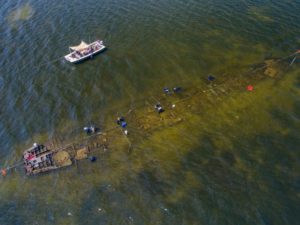Some of us living on Hatteras Island are perversely proud of the appellation “The Graveyard of the Atlantic.” The name refers to the more than 5,000 ships that have been wrecked on our North Carolina coast since record keeping began in 1526. Though we regret the loss of the lives and the goods essential to sustain them, the Graveyard chronicles our history. It makes us famous, or infamous, and the most dangerous spot on this great swath of turbulent water is our own Cape Point where sandbars constantly shift due to rough water created in part by the intersecting movements of the cold Labrador Current and the balmy waters of the Gulf Stream. The setting for over 600 shipwrecks, Cape Point is now, thanks to modern navigational methods and scientific inquiry, better known for spectacular fishing and consistently good surfing.
began in 1526. Though we regret the loss of the lives and the goods essential to sustain them, the Graveyard chronicles our history. It makes us famous, or infamous, and the most dangerous spot on this great swath of turbulent water is our own Cape Point where sandbars constantly shift due to rough water created in part by the intersecting movements of the cold Labrador Current and the balmy waters of the Gulf Stream. The setting for over 600 shipwrecks, Cape Point is now, thanks to modern navigational methods and scientific inquiry, better known for spectacular fishing and consistently good surfing.
But today it is the Sound Side of Hatteras Island that is the site of a major shipwreck, one that adds a mystery to history and, hopefully, attracts the human expertise and technology to solve it. Writer Mark Price of the Charlotte Observer frames our mystery: “How did a World War II assault vessel end up on the bottom of Pamlico Sound?”
Since 2010, Dr. Nathan Richards, Head of the UNC Coastal Studies Institute (UNC CSI), has studied the remains of the 100-plus foot steel-hulled vessel in the Pamlico Sound near Rodanthe. This past September he and a team of graduate students from East Carolina University’s (ECU) Program in Maritime Studies, in partnership with the North Carolina Department of Transportation (NCDOT), spent considerable time and effort investigating the shipwreck to ascertain the exact type of vessel it is so they could further identify it and systematically record it. Known as the Pappy’s Lane Shipwreck because of its proximity to a nearby Island road, the vessel’s remains are located in shallow brackish water in the path of the NC 12 Rodanthe Bridge project.
As a result of last September’s field work, the vessel is known to be either an LCI or an LCS, both of which served in the Pacific Theatre of World War II. The shallow draft LCIs were used to land troops on enemy beaches and were later modified to serve as gunboats to protect them. The LCSs were the specialized gunboats that resulted from the successful adaptation of the LCIs. After the war these serviceable ships were dispersed throughout the world. They became part of fleets in France, Vietnam and Japan. By the 1980s some were sold, scrapped or converted to commercial fishing boats. There may be only a very few left in the United States, and a couple of them have converted to floating museums.
So once again Hatteras Island offers up a bit of history and quite a lot of mystery. Research will continue to determine if Pappy’s Lane is an LCI or an LCS with that information, records of the 900 such vessels that served in the Pacific might be able to tell us where Pappy’s Lane has been and how it came to be off shore of Rodanthe in our own Pamlico Sound.
